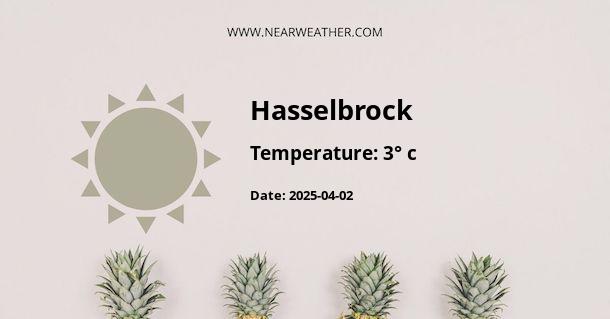Exploring the Climate and Weather of Hasselbrock, Germany
Hasselbrock, a charming locale situated in the Lower Saxony region of Germany, boasts a temperate climate that reflects the varied weather patterns frequently found across Central Europe. This detailed examination of Hasselbrock's climate will provide insights into the seasonal variations, weather trends, and meteorological influences that define this location's atmospheric character year-round. Data-driven observations, charts, and tables will highlight the climate specifics, enticing enthusiasts and visitors alike who seek to understand and appreciate the nuances of this German hideaway's environment.
Geographical Influence on Hasselbrock's Climate
The climate in Hasselbrock is significantly influenced by its geographic position. Situated in the northwestern part of Germany, it experiences a maritime climate thanks to the North Sea's proximity. This proximity results in mild winters and cool summers, with moderate rainfall distributed throughout the year. The North Sea also has a stabilizing effect on the temperature, reducing extremes and providing a general climate predictability.
Temperature Overview
Hasselbrock's temperature patterns are a classic embodiment of a temperate maritime climate, characterized by mild summers, cool winters, and a relatively narrow annual temperature range.
Summer
- June to August marks the summer period in Hasselbrock.
- Average high temperatures range from 19°C to 22°C.
- Nights are cool, with lows averaging around 12°C.
Winter
- December through February represents winter months.
- Average high temperatures are typically between 2°C and 4°C.
- Overnight lows hover around the freezing mark, occasionally dipping below 0°C.
Spring and Autumn
- Both spring and autumn feature moderate temperatures and a higher level of precipitation.
- Temperatures gradually rise from March to May, with averages between 8°C and 15°C.
- Autumn, ranging from September to November, sees a decline in the average, from 17°C down to 9°C.
Precipitation Patterns
Hasselbrock does not have a specific dry or wet season; instead, precipitation is quite evenly distributed throughout the year. The tables below demonstrate the average precipitation this area receives each month.
| Month | Average Precipitation (mm) |
|---|---|
| January | 70 |
| February | 50 |
| March | 60 |
| April | 47 |
| May | 58 |
| June | 70 |
| July | 78 |
| August | 72 |
| September | 65 |
| October | 67 |
| November | 77 |
| December | 78 |
This distribution of precipitation ensures that Hasselbrock's ecosystem remains lush, and natural water sources are maintained throughout the year. While rain is common, extreme precipitation leading to significant flooding is rare.
Sunlight and Daylight Hours
Seasonal changes in daylight is another aspect of weather that deeply affects life in Hasselbrock. Like many regions at comparable latitudes, Hasselbrock experiences long days in the summer and short days in the winter due to the tilt of the Earth's axis.
During the peak of summer, Hasselbrock can enjoy up to 17 hours of daylight, while in the darkest of winters, daylight may be limited to less than 8 hours.
Wind and Atmospheric Conditions
With Hasselbrock's proximity to the North Sea, the locality is influenced by westerly winds that have a bearing on both the climate and daily weather patterns. Winds tend to be stronger during the winter months when the sea's influence is more pronounced, and storm systems more robust. Yet, the local topography can shield the area from the harshest conditions, providing a relatively sheltered environment despite the open landscape.
Seasonal Weather Considerations for Travelers
Visitors planning a trip to Hasselbrock should consider packing differently based on the season. Layering is key since the weather can be quite variable:
- In summer, light clothing for sunny days, but always have a jacket for cooler evenings and potential rainfall.
- The winter wardrobe should focus on warmth, with coats, scarves, and gloves a must, particularly as frost and occasional snow are possible.
- During spring and autumn, it's wise to have a waterproof layer at hand as these seasons can bring unpredictable weather from delightful sunshine to sudden showers.
Climate Change Impact on Hasselbrock's Weather
As is the case globally, Hasselbrock faces the effects of climate change, which are reflected in its local weather patterns. Increases in temperature averages and variances in precipitation have prompted ongoing study and action within the community.
According to climate data, Hasselbrock has experienced an upward shift in its average annual temperature over the past decades, signaling potential long-term changes to its traditional maritime climate.
With these considerations, future forecasts might predict different statistics compared to historical data, which could lead to shifts in agricultural practices, natural flora and fauna distribution, as well as human comfort and activities.
Summary
With a deep dive into the climate and weather patterns of Hasselbrock, Germany, it is now evident that this enchanting location offers a stable yet dynamic environment influenced by maritime forces. The moderate temperature ranges, consistent precipitation, and the interplay of sunlight and wind all contribute to a distinctive climate that is as inviting as it is unique. Understanding these weather dynamics is essential for residents, travelers, and enthusiasts who will appreciate the setting's intensive yet gentle atmosphere.
Whether planning a visit, studying local ecosystems, or simply enjoying a virtual tour of German climates, Hasselbrock's weather narrative is an intriguing chapter in the vast and diverse meteorological story of Central Europe.
A - Hasselbrock's Latitude is 52.916672 & Longitude is 7.183330.
A - Weather in Hasselbrock is 10° today.
A - Climate Conditions in Hasselbrock shows light rain today.
A - Humidity in Hasselbrock is 98% today.
A - Wind speed in Hasselbrock is 11.7 km/h, flowing at 287° wind direction. today.
